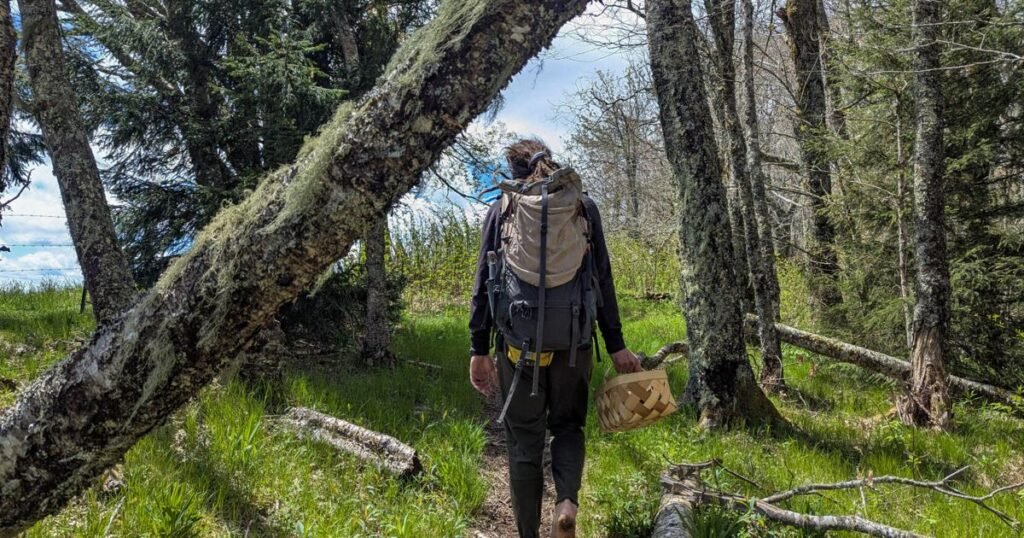Exploring the Wild Bounty: Foraging Adventures in Haywood County’s Great Smoky Mountains
There’s something magical about wandering through the misty valleys of the Great Smoky Mountains with the earth’s natural pantry spread before you. As someone who’s spent years exploring these ancient mountains, I can tell you there’s no experience quite like foraging for nature’s hidden treasures in Haywood County, North Carolina.
I still remember my first time tasting the bright, citrusy pop of mountain sorrel, plucked fresh from beside a mountain trail. That unexpected delight is what keeps me coming back to these hills season after season.
A Barefoot Guide to Nature’s Buffet
On a recent expedition through Haywood County, our group followed the knowledgeable Lee “Natty” Trebotich – a guide who quite literally feels the earth beneath his bare feet as he leads visitors through the region’s abundant natural larder. As we hiked with the majestic Great Smoky Mountains National Park forests rising to our right and pastoral ranchlands sloping away to our left, Natty’s eagle eyes spotted what most of us would walk right past.
“See those?” he asked, pointing toward what appeared to be ordinary green shoots nestled among trailside ferns. To the untrained eye, they were just part of the background greenery. To Natty, they were dinner.
The trail yielded delicate violets with their surprisingly sweet petals and lemony mountain sorrel that made our taste buds dance. These weren’t just plants – they were connections to the ancient knowledge of these mountains, little threads linking us to generations who foraged these same slopes centuries before.
Haywood County: A Forager’s Paradise
What makes Haywood County special for foraging enthusiasts is its remarkable biodiversity. The Great Smoky Mountains are home to more than 1,500 flowering plant species, with new discoveries still being made. The varying elevations, abundant rainfall, and four distinct seasons create perfect conditions for an ever-changing menu of wild edibles.
Seasonal Foraging Calendar
| Season | Common Finds | Best Locations |
|---|---|---|
| Spring | Ramps, morel mushrooms, violets, mountain sorrel | Lower elevations, forest edges |
| Summer | Blackberries, blueberries, chanterelles, jewelweed | Mid-elevations, sunny clearings |
| Fall | Chestnuts, walnuts, lion’s mane mushrooms | Hardwood forests, river valleys |
| Winter | Pine needles, birch bark, winter fungi | Protected slopes, south-facing ridges |
More Than Just Food: The Soul of Appalachian Culture
Foraging in these mountains isn’t merely about finding free food – it’s about connecting with a way of life that sustained generations of mountain folk. The Appalachian tradition of “wildcrafting” (gathering plants for food and medicine) runs deep in Haywood County’s cultural identity.
I’ve sat with local elders who can recall their grandparents teaching them which plants could soothe a cough or settle an upset stomach. These knowledge systems predate modern medicine, representing centuries of careful observation and experiential wisdom.
Responsible Foraging Practices
Guides like Natty emphasize the importance of ethical foraging. Here are some guidelines they share:
- Never harvest more than 1/3 of any plant population
- Learn to identify protected and endangered species
- Always get permission on private property
- Leave no trace of your presence
- Harvest only what you’ll use
Planning Your Own Foraging Adventure
If you’re inspired to explore Haywood County’s wild bounty, several local outfitters offer guided experiences for beginners and experienced foragers alike. These guided tours provide not just identification skills but also historical context and preparation techniques for your finds.
The best seasons for beginners are late spring and early summer when many easily identifiable edibles are abundant. Fall brings mushroom season, but I’d strongly recommend going with an expert guide if you’re new to fungal foraging – the consequences of misidentification can be serious.
What to Bring on a Foraging Expedition
- A field guide specific to the Southern Appalachians
- Paper bags (never plastic) for your finds
- A small knife or scissors
- Weather-appropriate clothing (layers are best)
- Plenty of water
- A camera to document plants you’re unsure about
Whether you’re a culinary adventurer seeking new flavors or simply someone who wants to connect more deeply with the natural world, Haywood County’s foraging landscape offers endless discoveries. There’s profound satisfaction in learning to read the landscape as our ancestors did – finding nourishment where others see only wilderness.
Join the Movement Back to Wild Foods
As interest in local, sustainable food sources grows, foraging represents both a link to our past and a path toward a more connected future. The next time you visit Western North Carolina, consider setting aside time to explore its edible landscapes. You might just discover that the most memorable flavors of your trip weren’t found on a restaurant menu but growing quietly along a mountain trail.
Have you ever foraged for wild foods? What unexpected edibles have you discovered in your own explorations? The Great Smoky Mountains are waiting with their secrets – all you need is a knowledgeable guide and curious taste buds to unlock them.

